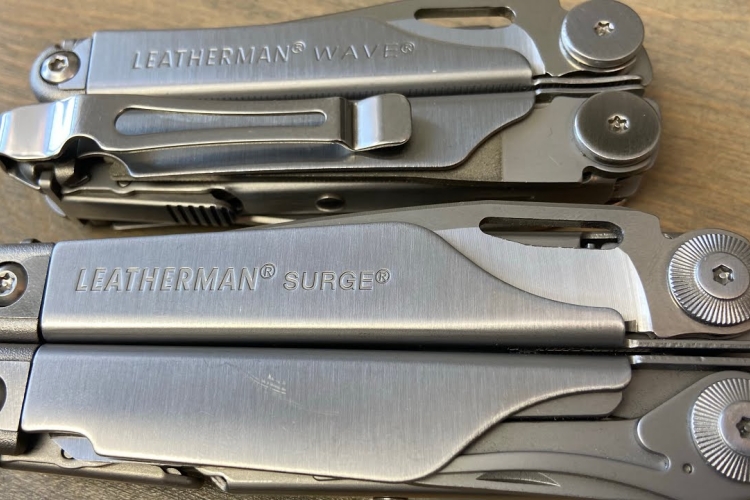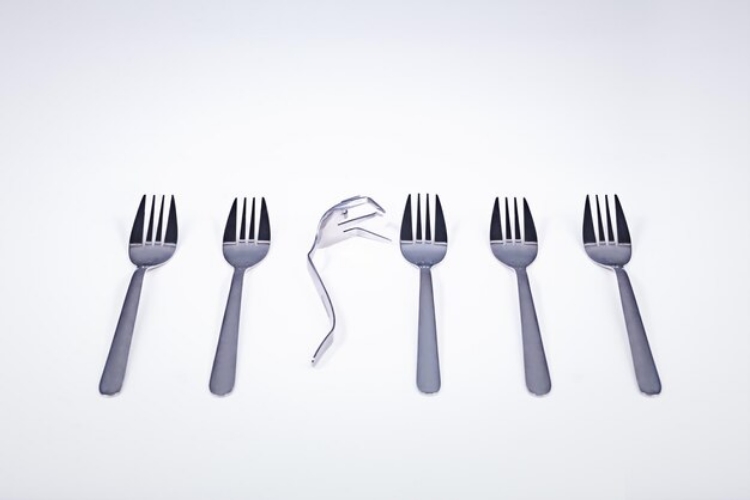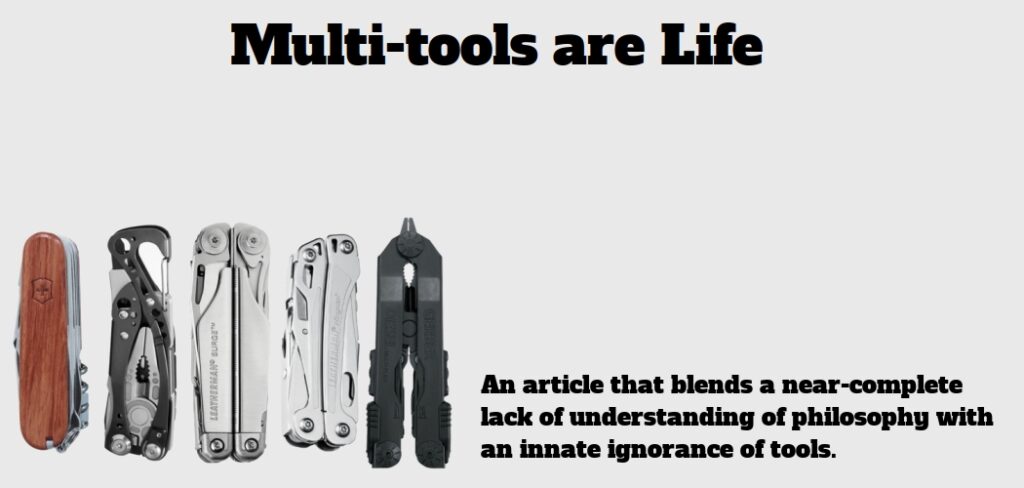Multi-Tools are life
A philosophical expression of something or other to do with EDC tools
Jack 'of all trades' Atkinson
I always wanted to have three things that do it all. As a minimalist who enjoys travel, I was always interested in packing light. That philosophy demands that a few things do a lot and I expect exactly that from everything I own.
Of course, for a general use multi-tool, the best recommendation is the Leatherman Wave. It’s the most popular option by far for a very good reason, it excels at what it does, if gives you everything you need in a small and affordable package. No other tool significantly improves on it, just offers different options for different uses.
But is it perfect?
Motorcycles, Laptops and Multi-tools
I always wanted to have just one motorcycle that could do everything the world asked of it. I dreamed of litre-class performance, the lighter weight of an off-road chassis matched with mid-range reliability and fuel-economy. Sadly, consumer technology and a century of technological evolution have failed to deliver on my fairly undemanding expectations. This is part of the reason I currently own five motorcycles—down from a peak of over twenty at one time—and the rest of the explanation comes down to an unhealthy obsession and fairly sever mental health problems. My travel bike, my BMW G650x came pretty close and hasn’t let me down under any circumstances, nor in any situation.
My second requirement is a good laptop. I like to be in touch, and as a writer, I like to work wherever I am. My current machine has proven to be exceptional trustworthy, much closer to the ideal than any bike has come. It’s the size and weight of a small book, has military-spec shock protection, could shrug off a terrorist attack, and processes full HD video while bench-pressing Trump Tower.
Finally, and perhaps most importantly, I like to have a really good multi-tool.
The multi-tool comes closer than any other thing in my life to the philosophy of a little being required to do a lot. It has to replace a small pack of tools and keep me ready and capable of fixing things as they choose to go wrong. I have found that the mark of a really good tool is that you should feel slightly lost without it.
Because these things are so important to me, I do a lot of research in advance. At first, way back in the 90s, I realised I needed a set of tools in my pocket and Swiss Army Knives were an obvious choice. Then, as I looked into it more, Leathermans came to my attention. The internet was still in its infancy and was only used for very slowly sharing a few small pornographic Jpegs—not much changed in real terms there. So, my research was mostly done by talking to actual, real people.

Leathermans
In the end, I rejected all the other brands and decided Leatherman was the right choice for me. It seemed to me that the other options in the market were—and still are—slightly inferior. But, other options are cheaper too and are sold according to their strengths. The options weren’t as wide (or confusing) as they are today, and the ‘Super Tool’ seemed to be the obvious choice for me. It was the largest, strongest and best in their range. I bought it and was quite happy with my selection for many subsequent years.
Eventually the ‘Wave’ hit the market. It reversed the design, putting the handgrips on the other way around, giving several distinct advantages. The primary blades were accessible without opening the tool and it was far more comfortable to hold and use.
I regarded it enviously, but reminded myself that mine was bigger, and therefore better.

Better by design
Then, one day, the pliers snapped, nipping the top of the jaw straight off while I tried to pull a nut out of a wheel, where it had been jammed inside. It was my own fault; I had twisted too hard and was pushing it beyond its design limitations. In fact, the tool had a near lifetime warranty, but I decided that I would rather trade up and handed the tool off to a friend to get it replaced if he chose. I would be upgrading to a newer, better model.
I ended up opting for a ‘Charge,’ the latest, greatest design. It had titanium handles and a blade made from a superior kind of steel. This one served me well until I lost it from a pocket while riding. I replaced it with a similar but cheaper version. Instead of titanium, this had aluminium sides, but otherwise seemed no different—other than being cheaper. The only net benefit was that it was black, against the dirty metallic grey of the old version.
Eventually this one was also lost.
The Charge ALX in aluminium had been my favourite tool: not as expensive, but not significantly different from the previous one. I had it the longest time and it felt light, slim and easy to carry. My mistake had been in putting it into the glovebox compartment of a bike I wasn’t familiar with, and the panel had fallen open on a bump without me realising.

A Surge of disappointment
By this time I was in Cambodia, and there were limited options for replacing it. The only way I could get one was from a different country. So, I arranged for a friend to bring one over from the United States.
Because of the difficulty in getting one, I did my research very, very carefully. A new option had become available – the Surge. The blades were bigger, the selection of tools seemed better and it was different. If I had to get a new tool, at least it was nice to get one I hadn’t seen before.
I never liked the Surge.
The quality seemed to have declined. It rusted and the blades pitted quite badly. The metal darkened and the tools eventually jammed up so that nothing would open without a fight.
I was also disappointed with the tools it came with. The tiny optician’s screwdriver had been omitted and there was now a replaceable driver as well as two fixed screwdriver blades which felt overly redundant. It seemed like bad choices had been made both from the designers and myself.

Magic metal
The titanium Charge now sits at the top of the pricing options. At face value, this seems ridiculous because it has the exact same tools as the Wave, only at double the price. The principle difference is the titanium sides—the other is constructed of 420 steel.
However, with some investigation, you find that the titanium sides aren’t structural—they’re decoration, and do nothing to improve the rigidity of the tool. You also find that the tools aren’t the same, they just look like they are. The Charge boasts a primary blade made of a superior steel to the one in the Wave. While visually identical, the difference is significant but invisible. It’s even harder to justify the cost, however, when you find that the superior blade is worth about $25 on eBay, less than a quarter of the price difference. The Surge, along with all other tools has the 420 steel in the tools, a metal with a stronger tendency to rust.
When it comes to multi-tools, or people for that matter, first impressions are deceptive and cannot be relied upon. The bigger ones don’t offer any advantages over the smaller ones, and in many cases, the difference is a net negative. This is especially true when the tools it is fitted with (or the capabilities the person has developed) don’t make any sense.
The high quality ones have questionable attributes. Higher-quality materials are great in knife blades, but are they really worth the cost when you find that they’re harder to sharpen and maintain? Is it worth paying more when the external surface veneers offer no function, and instead just add bulk that is of no value to the user?

Do your DIY tool yourself
It seems to me that the only way to get the most out of one of these things is to really take a step back. They can’t be judged on appearance; you have to take the time to investigate thoroughly and really learn how to fully understand what it is that you’re looking at. You have to work out what it is you really want and need.
Likewise with people, they are rarely what you see on the surface, and you will always find that your own criteria for judgement is flawed. You have to look deeper, and learn how to see what’s really there.
At the end of the day, the only way I will get the tool I really want is to build it myself: determine what it is that I uniquely need, and then combine the best of all the parts into something that does just that. There is no off-the-shelf option that fits my needs.
The same is true when it comes to self-development. I have to seek out the real truth of who it is I need to be, and create myself in my own image. To really know yourself, you have to accept and understand that you’re not other people’s labels: white or black, male or female, liberal or conservative. There are no generic, off-the-shelf, one-size-fits-all people. You are a distinct and unique individual beyond the scope of such vague superficial binaries.
That is the philosophy by which I built my motorcycle and my laptop. Eventually, it’s how I’ll have to construct my carry-tool.
It’s also the philosophy by which I continue to build myself.

Many thanks for reading this article. We hope it was interesting, informative and entertaining. Follow us on social media or share our content on your own pages. It helps us grow so we can create more free content to help you.


The best strategy in selecting a multi-tool is determining which one has the best bottle opener.